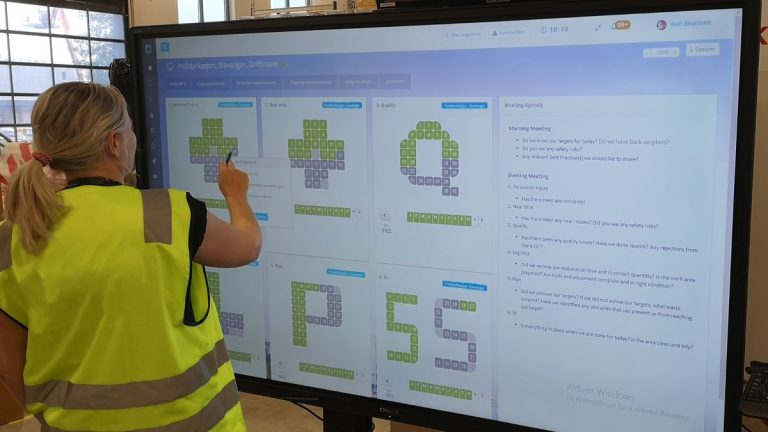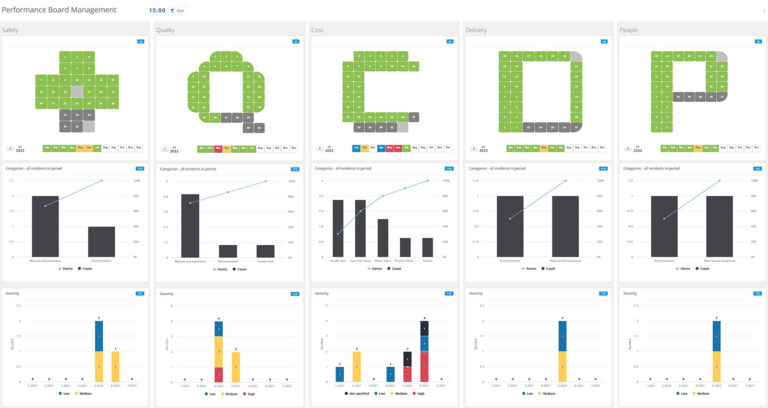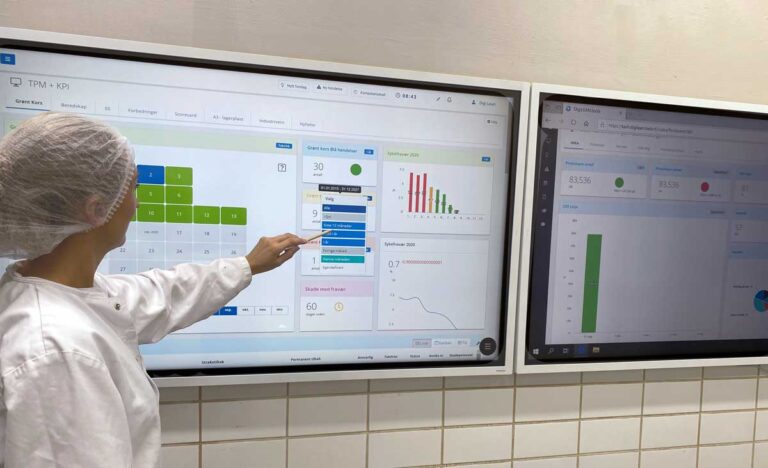- Product
Interactive boards. Fully customizable.
Capture, prioritize and follow up improvements.
Report and manage incidents. Visualize reports and statistics.
Operationalize your strategies and integrate your whole organization.
Access your tools in Microsoft Teams.
Customized templates. Problem solving, business development etc.
Manage project individually or in portfolios with visual and interactive tools.
Create and share best practices, one-point-lectures and standards.
Easy access to tasks, improvements and incidents.
Integrate DigiLEAN with your existing IT systems.
Meeting the demand of larger organizations.
High security level by default.
In less than 4 min
- Use Cases

Interactive tools for both shop floor and administration.
Visual project management.
Maintain standards. Manage incidents and discrepancies.
Manage tasks, integrate with problem-solving and continuous improvement.
Lean daily management tailored for healthcare.
Team task management, problem-solving and visualization.Case management, improvements, problem-solving, and strategy alignment.We have a LEAN solution for you too. Just ask!
We meet the demand of larger organizations.
- Pricing
- Blog
- Career
- Product
Interactive boards. Fully customizable.
Capture, prioritize and follow up improvements.
Report and manage incidents. Visualize reports and statistics.
Operationalize your strategies and integrate your whole organization.
Access your tools in Microsoft Teams.
Customized templates. Problem solving, business development etc.
Manage project individually or in portfolios with visual and interactive tools.
Create and share best practices, one-point-lectures and standards.
Easy access to tasks, improvements and incidents.
Integrate DigiLEAN with your existing IT systems.
Meeting the demand of larger organizations.
High security level by default.
In less than 4 min
- Use Cases

Interactive tools for both shop floor and administration.
Visual project management.
Maintain standards. Manage incidents and discrepancies.
Manage tasks, integrate with problem-solving and continuous improvement.
Lean daily management tailored for healthcare.
Team task management, problem-solving and visualization.Case management, improvements, problem-solving, and strategy alignment.We have a LEAN solution for you too. Just ask!
We meet the demand of larger organizations.
- Pricing
- Blog
- Career
Shop floor management with digital boards
Shop floor management starts at the bottom
Shop floor management is probably one of the most challenging things to do. In the split between the real operations, and the organization’s expectations, goals and supporting functions.
Up the chain
Production companies are often broken down into factories, production lines and work cells operated by 2-3 daily shifts.
There are normally a visual management board for each production line.
These are used to visualize important and useful information for the shop floor workers and team leaders.
In 15 minutes, the team gathers in front of the boards to review last shift handover, learning from yesterday, today’s plan, KPIs, issues and improvements. This is considered tier 1.
Issues that cannot be solved on the line are escalated to tier 2. The team leader brings on the issues from tier 1 to tier 2 meetings just afterwards.
The tier 2 meetings will manage the issues and performance across multiple work cells and production lines. Therefore, prioritization must take place. If the problem cannot be solved by tier 2, it is escalated to tier 3 and so on.
At the same time, the senior management (tier 3 and up) also needs to keep a pulse on the operations. They need aggregated status reports as well as performance reports.
Down the chain
Even though an issue is escalated to a higher tier level, the action plan is executed and implemented by the operators. Either locally on the line, or coordinated across if the change expands across multiple function areas.
The key here is that there is a link between the original issue, to the action plan coming back to the shop floor.
The employees becoming responsible for the implementation must have an understanding and ownership to the solution, and possibly be involved shaping the way it’s being implemented.
Challenges with shop floor management
Communication
Communication is the key success factor in any organization. It is also the number one reason for errors, incidents, conflicts, delays.
Escalating challenges from tier 1 and up is very much depending on a certain person, typically the leader who takes part in the next level meetings. The communication may suffer. Misunderstandings occur, and the actions and countermeasures are not addressing the right problem.
Manual Labor
The basis for the daily performance review are the metrics and KPIs. Again, very much depending on the team leader. S(he) has to manually extract the latest figures from various IT systems, add them to an Excel spreadsheet, update the charts, print them and update the whiteboards on the shop floor. This is very time-consuming.
Transparency
People need to feel involved and appreciated. Way too often shop floor workers are being left out and won’t receive any feedback until, and if, they are asked to do something. This strongly contributes to reduced motivation and engagement.
Coordination
In many cases the solution lays within process improvements, need for training, re-establish best practice. In other cases it’s just a matter of sharing learning and best practices, or aligning processes across functions. Getting everyone onboard with change processes are difficult.
Measurement
How do you know if you’re doing the right thing?
What is the return of investment on your improvements? Do you run operations with the right KPIs?
Even if you are measuring, it’s way too easy to wipe the results off the boards. And the next day or month, you won’t have access to the metrics from the previous period, as they are wiped off intentionally.
Digital shop floor boards

Digital boards adds solutions and opportunities.
Keep full track record of issues, priorities, decisions, and actions all in one place. As all information is retained, you will build a learning database to improve your standards and avoid repeatable problems.
Communicate, comment and leave notes to help and support communication between tiers.
On a daily basis, the boards provides the information and tools needed to quickly discuss performance, report issues, and follow up status and progress.
Integrate with your IT systems and avoid manually updating spreadsheets, prints and whiteboards. Let the KPI’s you need be updated automatically on the boards, and focus more on the daily agenda instead.

Issues, improvements and tasks can be escalated to other tiers. This simplifies the communication and adds transparency to the lower level tiers or the reporter of an issue. No longer pushing issues or idea into a void with no feedback. Keep an eye on your contributions and know how they are being processes.
Create a task force group across tiers or departments and plan, coordinate and implement tasks. With the communication capabilities and transparency with digital boards, it’s easy to align the plans and activities. Add you KPIs to the ingredients and you have an all-in-one management visualization platform. Measure your results, compare with your benchmark and rate your success.
Some finishing words
If you are skeptical, please read this.
If you book a live demo, we use the first minutes to hear from you. If your situation, your needs and requirements are not a match with our value proposal, we don’t need to do a demo at all.
However, if I think it might be a benefit for you, We’d like the opportunity to teach you how it can be utilized.
© 2024 DigiLEAN AS
